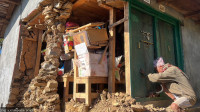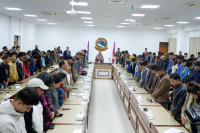Columns
Coughless Covid-19
Containment of any infectious agent is impossible without knowledge of its transmission.
Dr Sher Bahadur Pun
On December 31, 2019, the China country office of the World Health Organisation (WHO) received reports of a cluster of pneumonia of unknown cause in Wuhan city, Hubei Province of China, involving 44 patients, of which 11 were in serious condition. Initially, the WHO and Chinese authorities stated that there was no clear evidence of human-to-human transmission. However, it was later confirmed that the virus could spread through coughing, sneezing and respiratory droplets. Infection could then occur if a person touched these contaminated surfaces and subsequently touched their eyes, nose or mouth without proper hand hygiene.
In fact, on June 2, 2020, early in Nepal’s introduction to the Covid-19 pandemic, I published an article after observing that SARS-CoV-2, the causative agent of Covid-19, was spreading silently in the country, with most infections occurring without any cough. Even at Sukraraj Tropical & Infectious Disease Hospital, many staff members were infected with SARS-CoV-2 one after another, despite taking precautionary measures, yet almost none of them showed any cough symptoms. Interestingly, individuals with noticeable coughs were rarely seen in the community, even as the number of infected people or positive cases continued to rise during the pandemic. Could there have been alternative modes of Covid-19 transmission that facilitated its rapid global spread beyond cough or respiratory droplets? This intriguing possibility raises critical questions within the scientific community and challenges the conventional view of cough as a defining symptom of respiratory illnesses.
In Nepal, the first case of Covid-19 was reported in January 2020 in a 32-year-old male, who had returned from Wuhan, China. When I met him, he was experiencing shortness of breath rather than a cough. I spent at least 45 minutes with him (for history taking) without personal protective equipment, as his Covid-19 infection had not yet been confirmed.
Fortunately, subsequent laboratory testing showed that I was not infected with the virus. The patient received symptomatic treatment and recovered without complications. The first wave of Covid-19 in Nepal was observed to be less severe compared to neighbouring countries as well as other parts of the world, with nearly all individuals who tested positive remaining asymptomatic, including the absence of a cough. The second wave, also known as the Delta wave, which originated in India, was observed to be more severe than the first wave in Nepal. A significant number of young individuals succumbed to this wave.
While treating Covid-19 patients in the emergency ward, I observed that most patients did not have a cough; instead, they experienced shortness of breath and developed severe bilateral pneumonia, with many unfortunately succumbing within a few days. This may be attributed to government policies that prioritised the administration of Covid-19 vaccines to frontline workers and the elderly, leaving younger adults more vulnerable to severe outcomes. Interestingly, the second wave was associated with atypical symptoms, such as loss of smell and taste, which are not commonly observed in respiratory illnesses.
In contrast to the previous waves, the third wave, known as the “Omicron wave”, presented with typical respiratory symptoms, including cough. In fact, many individuals in Nepal initially attributed their flu-like illness symptoms to the common cold or seasonal flu before being tested and confirmed for the Omicron variant. These observations indicate that the first two waves were more severe than the third Omicron wave but were characterised by the absence of significant cough, a symptom typically associated with respiratory illnesses. This shift from classical symptoms made it difficult for physicians to suspect Covid-19, often delaying testing and diagnosis. Consequently, the timely implementation of preventive measures was hindered, allowing the virus to spread more rapidly.
Covid-19 was one of the most devastating pandemics in modern history. It raised critical questions among the scientific community, as a majority of the experts have predicted and agreed that the next pandemic, also referred to as ‘Disease X’, could be a Covid-19-like respiratory airborne disease. In general, to prevent respiratory infections, it is advised to avoid coughing without a mask, maintain hand hygiene, and avoid touching eyes, nose and mouth before cleaning hands. However, Covid-19 studies have demonstrated that the virus can also be transmitted through talking or singing in enclosed spaces, such as rooms, restaurants, or fitness classes. Later, the WHO recognised Covid-19 as an airborne disease, which may help explain its rapid global spread, potentially exacerbated by limited knowledge or delayed dissemination of preventive measures beyond mask-wearing, hand hygiene and physical distancing.
While cough has traditionally been considered a hallmark of respiratory illnesses, the Covid-19 pandemic, specifically the first two waves, has challenged this notion. Its widespread impact has sparked debate over a potential shift in classical symptoms, particularly the absence of cough in many cases, posing a significant challenge for healthcare workers in recognising and responding to future Covid-19-like respiratory pandemic diseases. This may even necessitate reconsidering the inclusion of cough in the case definitions of respiratory illnesses. Therefore, there is a need for more comprehensive, high-quality studies to better understand the routes of Covid-19 transmission, particularly if they extend beyond our current knowledge. Such insights would facilitate more effective control of viral spread and the implementation of more accurate preventive measures.
Notably, many experts anticipate that the next ‘Disease X’ or pandemic could be a Covid-19-like respiratory airborne disease. Thus, an in-depth study of Covid-19 transmission is critical for timely and effective control of outbreaks or pandemics, as containment of any infectious agent is impossible without comprehensive knowledge of its transmission dynamics.




 18.12°C Kathmandu
18.12°C Kathmandu















